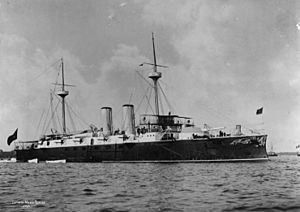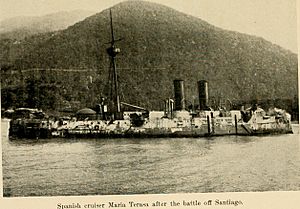Spanish cruiser Infanta Maria Teresa facts for kids
class="infobox " style="float: right; clear: right; width: 315px; border-spacing: 2px; text-align: left; font-size: 90%;"
| colspan="2" style="text-align: center; font-size: 90%; line-height: 1.5em;" | 
|}
The wreck of Infanta Maria Teresaaground on the south coast of Cubaafter the Battle of Santiago de Cuba
The Infanta María Teresa was a powerful warship built for the Spanish Navy. She was the first ship of her kind, known as an armoured cruiser. These ships were designed to be fast and carry heavy guns, while also having some armor protection. The Infanta María Teresa played a key role in the Spanish–American War, especially during the Battle of Santiago de Cuba.
Contents
| History | |
|---|---|
| Name | Infanta María Teresa |
| Namesake | Maria Theresa of Spain |
| Builder | Bilbao, Spain |
| Laid down | 1889 |
| Launched | 30 August 1890 |
| Completed | 1893 |
| Fate | Sunk 3 July 1898; captured and later refloated by the U.S. Navy, but lost in a storm while under tow. |
| General characteristics | |
| Class and type | Infanta Maria Teresa-class armored cruiser |
| Displacement | 6,890 tons |
| Length | 364 ft 0 in (110.95 m) |
| Beam | 65 ft 2 in (19.86 m) |
| Draft | 21 ft 6 in (6.55 m) maximum |
| Installed power | 13,700 ihp (10,200 kW) |
| Propulsion | 2-shaft vertical triple expansion |
| Speed | 20.2 knots (37.4 km/h; 23.2 mph) forced draft |
| Complement | 484 officers and enlisted |
| Armament |
|
| Armor |
|
| Notes | 1,050 tons of coal (normal) |
Building and Design of the Ship
The Infanta María Teresa was built in Bilbao, a city in northern Spain. Her design came from a British company called Palmers Shipbuilding and Iron Company. Work on the ship began in 1889. She was officially launched into the water on August 30, 1890, and was finished in 1893.
The ship had two tall funnels and could travel very fast. She also carried many guns. Her largest guns were placed in special armored towers at the front and back of the ship. However, her armor was not very strong. For example, her biggest guns had only light armor around them. Smaller guns were completely open on the upper deck. The ship's main armor belt was thin and covered only two-thirds of her length.
Like many warships from the 1800s, the Infanta María Teresa had a lot of wood inside. This wood was used for furniture and decorations. Unfortunately, the Spanish navy did not remove this wood before battles. This made the ship more likely to catch fire if hit. In 1895, the ship was important enough to represent Spain at the opening of the Kiel Canal in Germany.
The Ship's Journey and Battles
The Infanta María Teresa was the main ship, or flagship, for Spanish Vice Admiral Pascual Cervera y Topete. He was the commander of Spain's 1st Squadron. Tensions grew between Spain and the United States after the American battleship Maine exploded in Havana, Cuba, in February 1898.
Heading to Cuba
Admiral Cervera's squadron gathered at São Vicente in the Cape Verde Islands. They left Spain on April 8, 1898. The Infanta María Teresa and other ships arrived at São Vicente on April 14. They had problems with their engines and used too much coal on the way. It was also found that many of the ship's guns had problems, and there wasn't enough ammunition. The fleet also needed more stokers, who were the crew members who shoveled coal into the ship's furnaces.
The Spanish–American War began while the ships were at São Vicente. Portugal, where São Vicente is located, was neutral. This meant the Spanish ships had to leave within 24 hours. So, on April 29, 1898, the squadron set sail for San Juan, Puerto Rico.
They reached Martinique on May 10. France, which owned Martinique, was also neutral and would not give them coal. The ships then went to Curaçao, hoping to get coal there. The Netherlands, which owned Curaçao, was also neutral. They only allowed Infanta María Teresa and her sister ship Vizcaya to enter port. They could only load 600 tons of coal.
On May 15, the ships left Curaçao. They changed their destination from San Juan, which was now blocked by the U.S. Navy, to Santiago de Cuba. They arrived there on May 19, 1898. Admiral Cervera hoped to fix his ships before they got trapped. But an American squadron arrived on May 27 and started a blockade. This blockade lasted for 37 days.
Trapped in Santiago de Cuba
During the blockade, the Infanta María Teresa and other ships faced occasional attacks from American warships. The Infanta María Teresa still had serious issues with her 140 mm gun ammunition; 80 percent of it was faulty. Some of her crew even joined a special naval group to fight on land against the U.S. Army advancing toward Santiago de Cuba.
By early July 1898, the American forces were close to capturing Santiago de Cuba. Admiral Cervera decided the only way to save his squadron was to try to escape into the open sea. The plan was made on July 1, 1898, for the breakout to happen on July 3. The crew of Infanta María Teresa spent July 2 getting ready for battle.
Admiral Cervera was on board the Infanta María Teresa. She was to lead the escape. Her job was to attack the fastest American ship, the armored cruiser Brooklyn. This would allow the other Spanish ships to get away.
The Battle of Santiago de Cuba
The Spanish ships began to leave the harbor at 8:45 AM on July 3, 1898. The American ships saw them around 9:35 AM, and the Battle of Santiago de Cuba began. As the lead ship, Infanta María Teresa was the first to face heavy fire from the American fleet.
With Vizcaya close behind, and other Spanish ships turning to escape west, Infanta María Teresa bravely charged toward the Brooklyn. She got very close, forcing the Brooklyn to turn away. The Infanta María Teresa then turned west, trying to get past the American ships.
Soon, several American battleships, including Iowa, Oregon, and Indiana, joined the fight. Both sides fired their guns as fast as they could. One of the first shells from Iowa hit the back gun tower of Infanta María Teresa. This killed or wounded the crew and knocked out the gun.
The Infanta María Teresa took many more hits. Fires broke out on board, threatening to explode the ship's ammunition. Seeing no hope, Admiral Cervera ordered the ship to be beached at 10:20 AM. She turned and ran aground at 10:25 AM, a few miles west of Santiago de Cuba. The ship's flag was lowered, and the ammunition rooms were flooded to prevent explosions.
Some of the crew made it to shore, but they had to be careful of Cuban fighters. Other crew members were rescued by American sailors who brought small boats to the wreck.
After the Battle
After the war, the U.S. Navy tried to fix the Infanta María Teresa to use her. She was towed to Guantánamo Bay, Cuba, for small repairs. Then, a repair ship towed her toward Norfolk, Virginia, where bigger repairs could be done.
However, a strong storm hit during the journey. The Infanta María Teresa began to sink. Her crew was taken off by another ship. The Infanta María Teresa then sank between two reefs near Cat Island in the Bahamas. She broke apart and was completely lost.
Memorials to the Ship
After the Infanta María Teresa sank, the United States saved several of her cannons.
- One of her 140 mm guns is now on display in Groton, Connecticut.
- Another cannon, which shows battle damage, is at Veterans Memorial Park in Ottumwa, Iowa. A plaque there says it was from Admiral Cervera's flagship.
- A third cannon from the ship is displayed at the Minneapolis Veterans Home in Minnesota.
See also
 In Spanish: Infanta María Teresa para niños
In Spanish: Infanta María Teresa para niños



